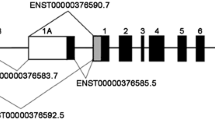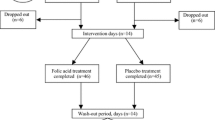Abstract
Two functional single nucleotide polymorphisms, 677C > T and 1298A > C have been described for the methylenetetrahydrofolate (MTHFR) gene. Both are associated with reduced enzyme activity in vitro. For the 677T, but not the 1298C allele, significantly lower serum folate and higher plasma total homocysteine (tHcy) have been reported. We genotyped 10,034 middle-aged (50–64 years old) subjects and measured serum folate and tHcy. Within strata of 677 genotypes, 1,298 genotypes had significantly different serum folate and tHcy (P ≤ 0.03 for all comparisons). Each additional 1298C allele reduced mean serum folate and increased mean tHcy, by (on average) 4.5 and 3.0%, respectively. In comparison, within strata of 1,298 genotypes, the increase from no, to one 677T-allele reduced serum folate and increased tHcy by, 7.1 and 6.3%, respectively. Lowest serum folate and highest tHcy level was found for the 677TT/1298AA genotype. The difference in tHcy was significantly larger at low folate than at high folate when genotypes 677TT/1298AA and 677CT/1298AA, 677CT/1298AC and 677CC/1298AC, and genotypes 677CT/1298AC and 677CT/1298AA were compared. We interpreted these data in the context of a model of the MTHFR enzyme that describes the enzyme as a dimer that mainly exist in six different configurations. The model reconciled the observed phenotypic effects of the 677/1,298 combination genotypes with previous in vitro measurements, and identified enzyme configurations that are sensitive to low folate levels. In conclusion, this report demonstrates functional inference of the MTHFR 677 C > T and 1,298 A > C polymorphisms from a large-scale epidemiological study.



Similar content being viewed by others
References
Barrett JC, Fry B, Maller J, Daly MJ (2005) Haploview: analysis and visualization of LD and haplotype maps. Bioinformatics 21:263–265
Bretthauer M, Gondal G, Larsen K, Carlsen E, Eide TJ, Grotmol T, Skovlund E, Tveit KM, Vatn MH, Hoff G (2002) Design, organization and management of a controlled population screening study for detection of colorectal neoplasia: attendance rates in the NORCCAP study (Norwegian Colorectal Cancer Prevention). Scand J Gastroenterol 37:568–573
Chango A, Boisson F, Barbe F, Quilliot D, Droesch S, Pfister M, Fillon-Emery N, Lambert D, Fremont S, Rosenblatt DS, Nicolas JP (2000) The effect of 677C– > T and 1298A– > C mutations on plasma homocysteine and 5,10-methylenetetrahydrofolate reductase activity in healthy subjects. Br J Nutr 83:593–596
Fiskerstrand T, Refsum H, Kvalheim G, Ueland PM (1993) Homocysteine and other thiols in plasma and urine: automated determination and sample stability. Clin Chem 39:263–271
Frosst P, Blom HJ, Milos R, Goyette P, Sheppard CA, Matthews RG, Boers GJ, den Heijer M, Kluijtmans LA, van den Heuvel LP et al (1995) A candidate genetic risk factor for vascular disease: a common mutation in methylenetetrahydrofolate reductase. Nat Genet 10:111–113
Gellekink H, den Heijer M, Heil SG, Blom HJ (2005) Genetic determinants of plasma total homocysteine. Semin Vasc Med 5:98–109
Guenther BD, Sheppard CA, Tran P, Rozen R, Matthews RG, Ludwig ML (1999) The structure and properties of methylenetetrahydrofolate reductase from Escherichia coli suggest how folate ameliorates human hyperhomocysteinemia. Nat Struct Biol 6:359–365
Harmon DL, Woodside JV, Yarnell JW, McMaster D, Young IS, McCrum EE, Gey KF, Whitehead AS, Evans AE (1996) The common ‘thermolabile’ variant of methylene tetrahydrofolate reductase is a major determinant of mild hyperhomocysteinaemia. Qjm 89:571–577
Jacques PF, Bostom AG, Williams RR, Ellison RC, Eckfeldt JH, Rosenberg IH, Selhub J, Rozen R (1996) Relation between folate status, a common mutation in methylenetetrahydrofolate reductase, and plasma homocysteine concentrations. Circulation 93:7–9
Kang SS, Zhou J, Wong PW, Kowalisyn J, Strokosch G (1988) Intermediate homocysteinemia: a thermolabile variant of methylenetetrahydrofolate reductase. Am J Hum Genet 43:414–421
Kelleher BP, Broin SD (1991) Microbiological assay for vitamin B12 performed in 96-well microtitre plates. J Clin Pathol 44:592–595
Lewis SJ, Ebrahim S, Davey Smith G (2005) Meta-analysis of MTHFR 677C- > T polymorphism and coronary heart disease: does totality of evidence support causal role for homocysteine and preventive potential of folate? Bmj 331:1053
Lievers KJ, Boers GH, Verhoef P, den Heijer M, Kluijtmans LA, van der Put NM, Trijbels FJ, Blom HJ (2001) A second common variant in the methylenetetrahydrofolate reductase (MTHFR) gene and its relationship to MTHFR enzyme activity, homocysteine, and cardiovascular disease risk. J Mol Med 79:522–528
Ma J, Stampfer MJ, Hennekens CH, Frosst P, Selhub J, Horsford J, Malinow MR, Willett WC, Rozen R (1996) Methylenetetrahydrofolate reductase polymorphism, plasma folate, homocysteine, and risk of myocardial infarction in US physicians. Circulation 94:2410–2416
Meyer K, Fredriksen A, Ueland PM (2004) High-level multiplex genotyping of polymorphisms involved in folate or homocysteine metabolism by matrix-assisted laser desorption/ionization mass spectrometry. Clin Chem 50:391–402
Molloy AM, Scott JM (1997) Microbiological assay for serum, plasma, and red cell folate using cryopreserved, microtiter plate method. Methods Enzymol 281:43–53
Ogino S, Wilson RB (2003) Genotype and haplotype distributions of MTHFR677C > T and 1298A > C single nucleotide polymorphisms: a meta-analysis. J Hum Genet 48:1–7
Rosenberg N, Murata M, Ikeda Y, Opare-Sem O, Zivelin A, Geffen E, Seligsohn U (2002) The frequent 5,10-methylenetetrahydrofolate reductase C677T polymorphism is associated with a common haplotype in whites, Japanese, and Africans. Am J Hum Genet 70:758–762
Schneede J, Refsum H, Ueland PM (2000) Biological and environmental determinants of plasma homocysteine. Semin Thromb Hemost 26:263–279
Stephens M, Donnelly P (2003) A comparison of bayesian methods for haplotype reconstruction from population genotype data. Am J Hum Genet 73:1162–1169
Stephens M, Smith NJ, Donnelly P (2001) A new statistical method for haplotype reconstruction from population data. Am J Hum Genet 68:978–989
Ueland PM, Hustad S, Schneede J, Refsum H, Vollset SE (2001) Biological and clinical implications of the MTHFR C677T polymorphism. Trends Pharmacol Sci 22:195–201
Ulrich CM (2005) Nutrigenetics in cancer research-folate metabolism and colorectal cancer. J Nutr 135:2698–2702
Ulvik A, Ueland PM (2001) Single nucleotide polymorphism (SNP) genotyping in unprocessed whole blood and serum by real-time PCR: application to SNPs affecting homocysteine and folate metabolism. Clin Chem 47:2050–2053
van der Put NM, Gabreels F, Stevens EM, Smeitink JA, Trijbels FJ, Eskes TK, van den Heuvel LP, Blom HJ (1998) A second common mutation in the methylenetetrahydrofolate reductase gene: an additional risk factor for neural-tube defects? Am J Hum Genet 62:1044–1051
Weisberg I, Tran P, Christensen B, Sibani S, Rozen R (1998) A second genetic polymorphism in methylenetetrahydrofolate reductase (MTHFR) associated with decreased enzyme activity. Mol Genet Metab 64:169–172
Weisberg IS, Jacques PF, Selhub J, Bostom AG, Chen Z, Curtis Ellison R, Eckfeldt JH, Rozen R (2001) The 1298A– > C polymorphism in methylenetetrahydrofolate reductase (MTHFR): in vitro expression and association with homocysteine. Atherosclerosis 156:409–415
Yamada K, Chen Z, Rozen R, Matthews RG (2001) Effects of common polymorphisms on the properties of recombinant human methylenetetrahydrofolate reductase. Proc Natl Acad Sci USA 98:14853–14858
Acknowledgments
This study received financial support from the Norwegian Cancer Society, the Norwegian Department of Health and Social Affairs, and the Foundation to Promote Research into Functional Vitamin B12-deficiency.
Author information
Authors and Affiliations
Corresponding author
Rights and permissions
About this article
Cite this article
Ulvik, A., Ueland, P.M., Fredriksen, Å. et al. Functional inference of the methylenetetrahydrofolate reductase 677 C > T and 1298A > C polymorphisms from a large-scale epidemiological study. Hum Genet 121, 57–64 (2007). https://doi.org/10.1007/s00439-006-0290-2
Received:
Accepted:
Published:
Issue Date:
DOI: https://doi.org/10.1007/s00439-006-0290-2




